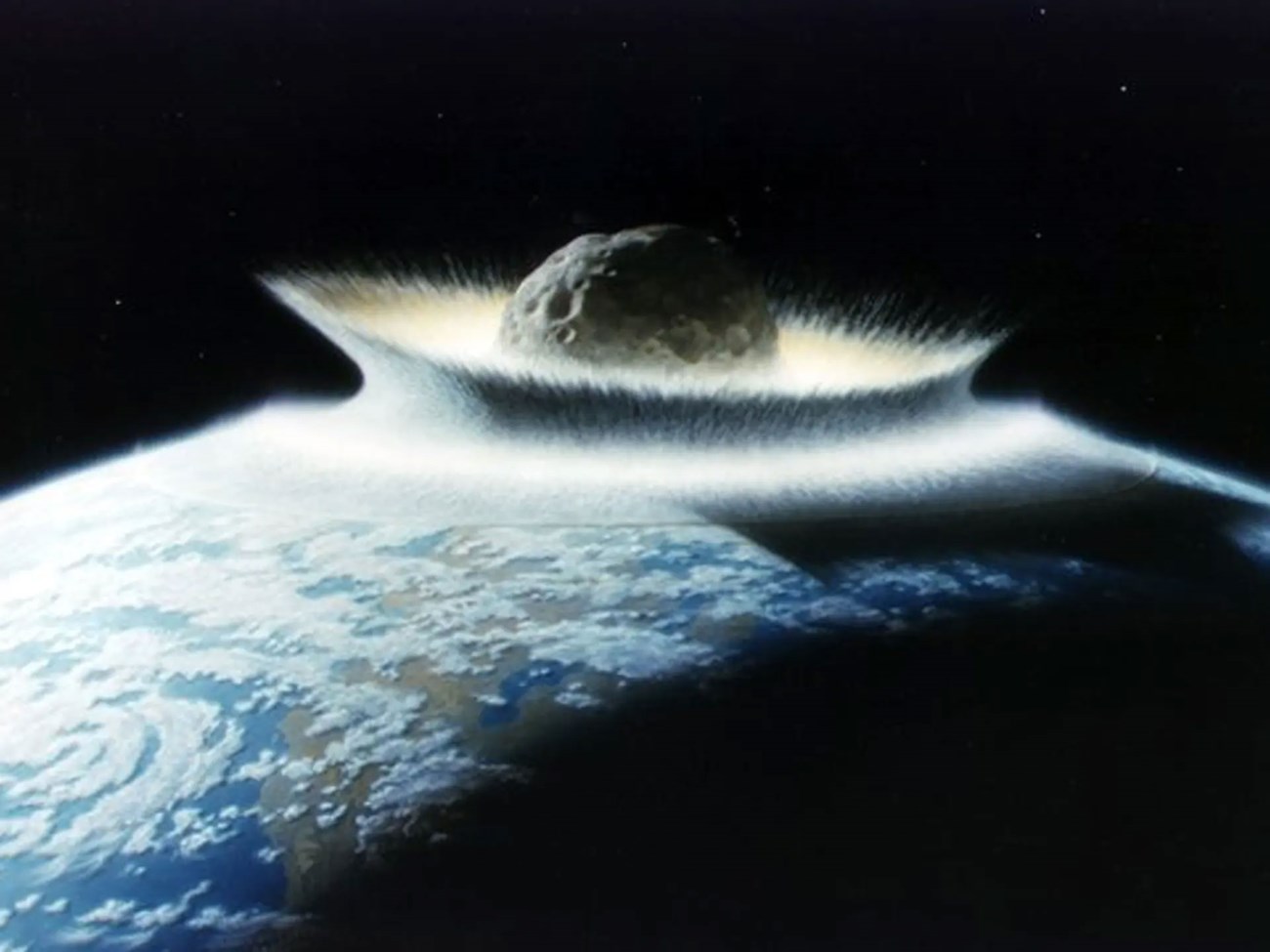
NASA/Don Davis.
Introduction
Extinction is a natural part of the changing tableau of life on Earth, and it interplays with evolution. Its main importance is that it is one of the factors that has led to the diversity of life through geologic time. Most species only exist for a few million years or so, although the length of time that any given species persists is highly variable. Species become extinct due to many different reasons, such as: evolution into a new species, competition, predation, disease, loss of available habitat, climate change, and as a result of catastrophic events such as periods of intense volcanic activity or even asteroid impacts or other events with an extraterrestrial origin. It is estimated that more than 99% of all species that have lived through the scope of geologic time are extinct.
Usually, the rate that species become extinct is relatively low compared to the number of species alive at any given time, so that new species arise to fill in behind species that have gone extinct and the diversity of life remains roughly constant.However, major extinction events (mass extinctions) are different. Mass extinctions are spikes or rapid increases in extinction rates that occur over short periods of geologic time, leading to substantial drops in global biodiversity.
Five mass extinction events through geologic time are known for their particularly profound impacts on life on Earth. They are sometimes called the “Big Five:”
-
End Ordovician
-
Late Devonian
-
End Permian
-
End Triassic
-
End Cretaceous
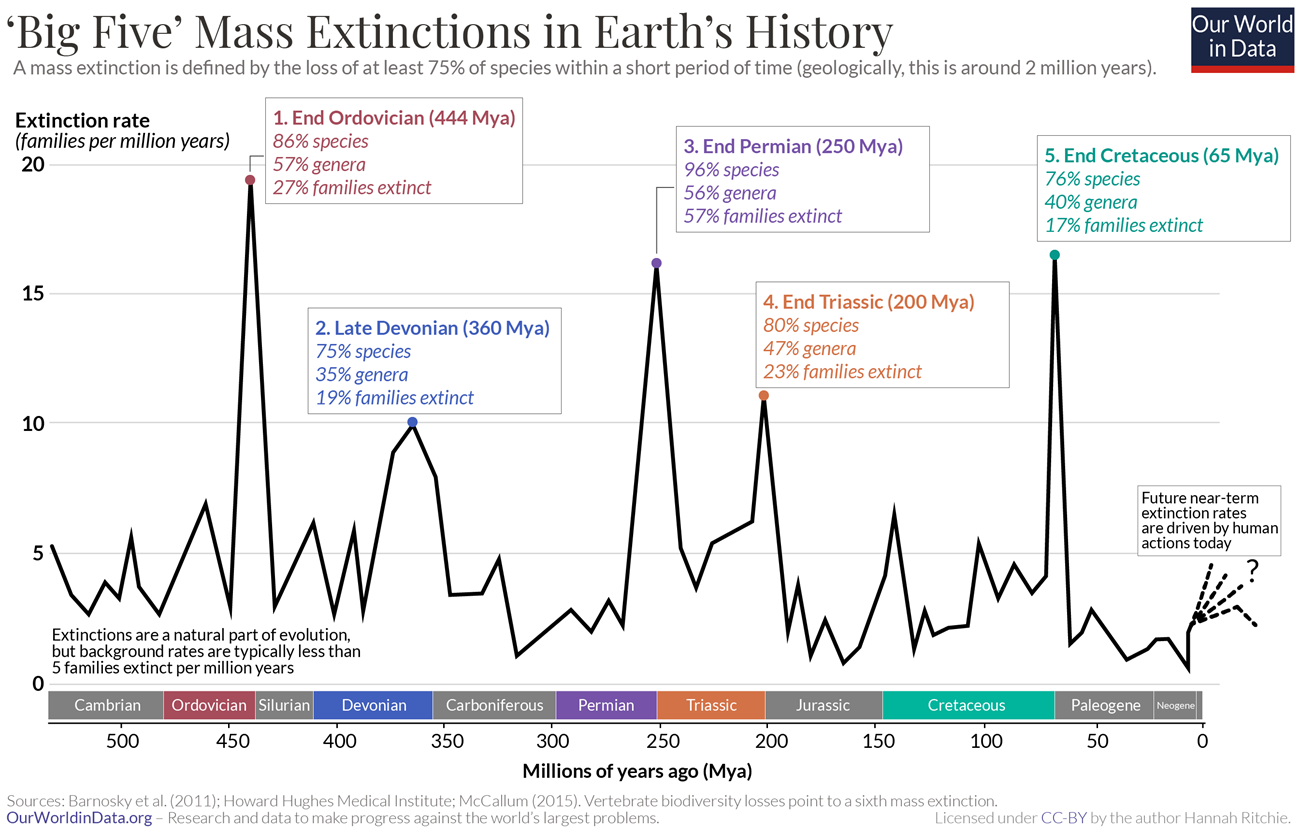
Mass extinctions not only lead to massive reductions in the numbers of living species and genera, but also losses of entire major groups, such as trilobites at the End-Permian extinction and dinosaurs (except birds) at the End-Cretaceous extinction. Mass extinctions are typically followed by evolutionary bursts or radiations within surviving groups of organisms, such as mammals after dinosaurs became extinct at the end of the Cretaceous. The combined effect of mass extinctions and the following evolutionary bursts is that new groups of organisms fill niches previously filled by now-extinct organisms.
Most of the information we have about the Big Five mass extinctions comes from marine invertebrates. Many marine invertebrates have excellent fossil records and studies of their taxa (especially genera, families, and higher levels) have allowed paleontologists to document the percentages of these groups that were impacted by extinction events.
The End-Triassic and End-Cretaceous extinctions also greatly impacted terrestrial vertebrates, leading to dramatic changes in familiar groups of animals. For example, the End-Cretaceous extinction is most popularly known for the demise of the dinosaurs.
Learn More
Coral Reefs and Mass Extinctions
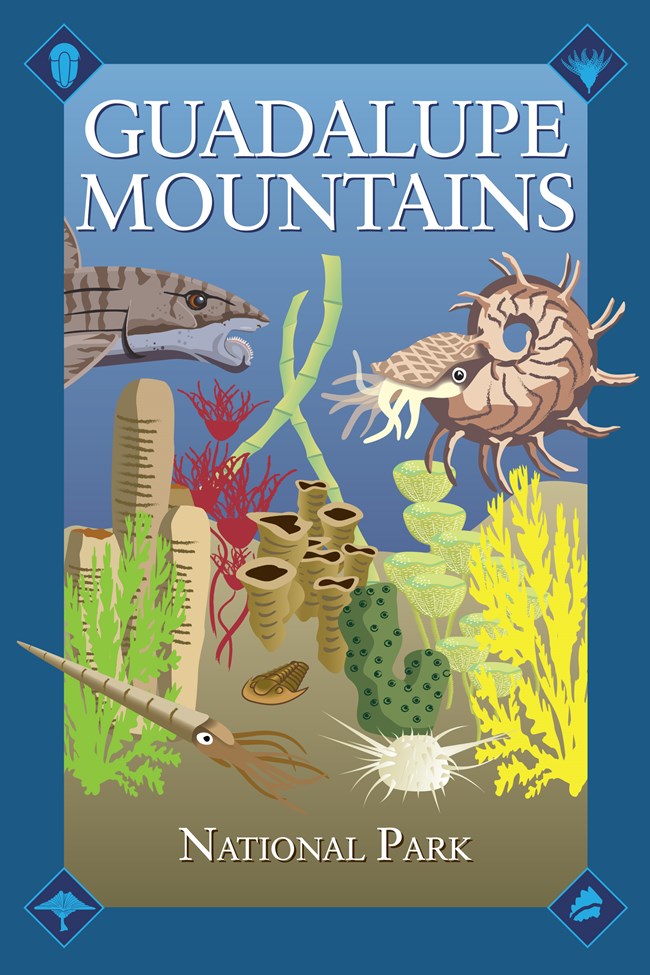
NPS image.
In the Cambrian period, archaeocyathid sponges built reefs, until they went extinct during a minor event at that time. During the Ordovician, tabulate corals and stromatoporoid sponges constructed reefs, but they suffered a setback at the End-Ordovician extinction. Great Basin National Park in Nevada contains Ordovician marine sedimentary rocks with evidence of this type of reef. Devonian reefs like those in Delaware Water Gap National Recreation Area in Pennsylvania and New Jersey were dominated by stromatoporoid, but these reefs were wiped out in the End-Devonian event.
Late Permian reefs such as the Capitan Reef in Guadalupe Mountains National Park in Texas were made of phylloid (calcareous) algae, sponges, and bryozoan, but those were hit by the End-Permian extinction.
Following the reef-building ecological niche opening up after the End-Permian extinction, stony (scleractinian) corals built reefs, but they were impacted by the End-Triassic extinction. During the Cretaceous, rudist bivalves formed reefs, with important fossils of these reefs present in Amistad National Recreation Area in Texas. But in turn, rudists died out at the Cretaceous-Paleogene boundary. Modern reefs, like those in Biscayne National Park in Florida, are mostly made of stony (scleractinian) corals.
The Big Five Mass Extinctions
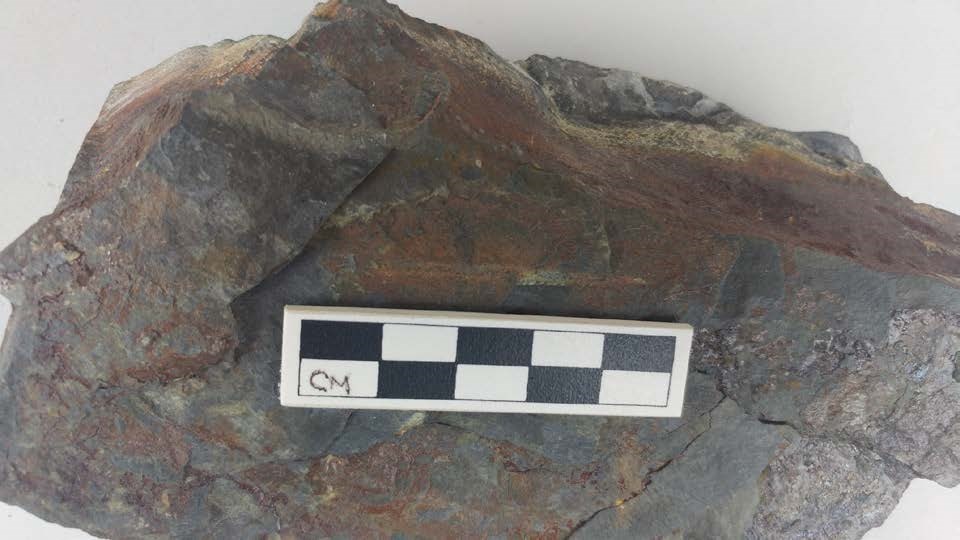
NPS photo by Ariana Miranda.
The End-Ordovician extinction occurred approximately 444 million years ago and was the first mass extinction event that is well documented in the fossil record. It is mostly seen in the fossil record of marine invertebrates: many brachiopods, trilobites, bryozoans, and graptolites became extinct in two short pulses separated by a geologically short time. Overall, about 86% of species, 57% of genera, and 27% of taxonomic families died out, making this the second largest extinction in the Phanerozoic.
This extinction appears to be related to an episode of rapid glaciation and its abrupt retreat on the supercontinent Gondwana (the modern continents of the Southern Hemisphere). Gondwana was centered low in the Southern Hemisphere at the time, partially over the South Pole, which along with a change in climatic conditions to icehouse conditions caused extensive glaciations. The glaciation lowered global sea level, which also reduced the area of continental shelves and drained shallow continental seas, causing habitat loss for the species that inhabited these areas. The second pulse of the End-Ordovician extinction likely occurred when warm climatic conditions returned.
Related Links
Late-Devonian Extinction

NPS photo by Gordon Bell.
Like the End-Ordovician extinction, the Late-Devonian extinction was not a single event. The most critical event occurred about 372 million years ago, partway through the Late Devonian. It had wide ranging impacts on life: 75% of species, 35% of genera, and 19% of taxonomic families died out. This extinction seems to have mostly impacted marine life, although little is known on its impact on land organisms.
In the oceans, this extinction caused a major loss of biodiversity and fundamental changes to some marine environments. For examples, stromatoporoid sponges, which had been major reef builders since the Middle Ordovician, became extinct, along with placoderm fishes (armored fishes with jaws). Large numbers of brachiopods and trilobite species also died out.
The cause of this extinction is not very clear and there is not strong evidence for any single cause. Researchers have suggested a variety of potential causes, including global cooling, volcanic activity, an impact by a comet or other extraterrestrial object, and an overabundance of nutrients in the water leading to algal blooms and low oxygen availability in water. Several of these potential causes may be due to the development of forests on land. Global cooling could result from carbon dioxide being drawn out of the air, directly by growing land plants and indirectly by increased weathering of rocks by plants. Increased weathering by plants would also release more nutrients into water.
Related Links
End-Permian Extinction

NPS photos.
Massive volcanic eruptions of flood basalts in Siberia are thought to be the triggering cause of this mass extinction. Volcanic eruptions emit great amounts of gases including carbon dioxide (CO2) and sulfur dioxide (SO2) that can lead to climate change and ocean acidification. It was a time of intense climate variability and abrupt sea-level change, and most species could not adapt quickly enough to survive.
Related Links
End-Triassic Extinction
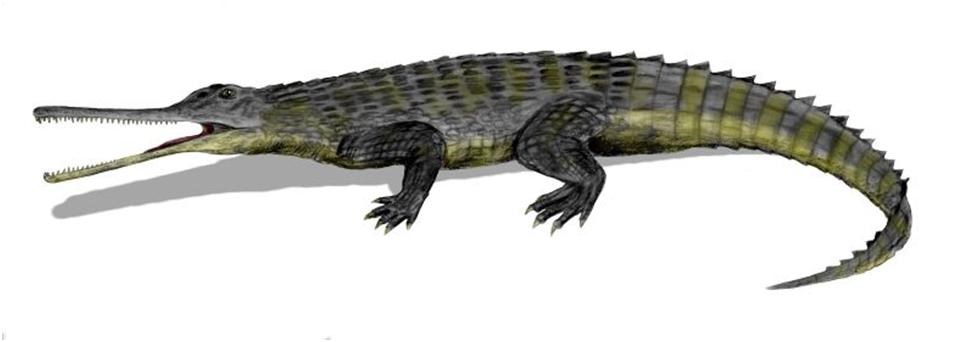
NPS image.
The End-Triassic extinction at about 200 million years ago was much less severe than the End-Permian and End-Cretaceous events that preceded and followed it. Still, it remade life, with an estimated 80% of species, 47% of genera, and 23% taxonomic families dying out.
Important groups of both marine and terrestrial organisms became extinct. Ammonites nearly became extinct, and bivalves and corals were also greatly impacted. The End-Triassic extinction also caused many groups of terrestrial vertebrates to die out, resulting in very different land faunas in the Jurassic. Once-dominant groups like phytosaurs disappeared, allowing dinosaurs to thrive.
The extinctions occurred over a period of some time and may not have all resulted from a single event. The major cause is thought to have been the opening of the Atlantic Ocean as the supercontinent Pangea broke up. Africa and Europe separated from North America and South America. The opening of the Atlantic Ocean included volcanic eruptions that took place over thousands of miles along the rifts, affecting the atmosphere and oceans.
Related Links
- NPS—Geologic Time Periods in the Mesozoic Era—Triassic Period
- NPS—Age of Dinosaurs—Extinction Events
End-Cretaceous Extinction
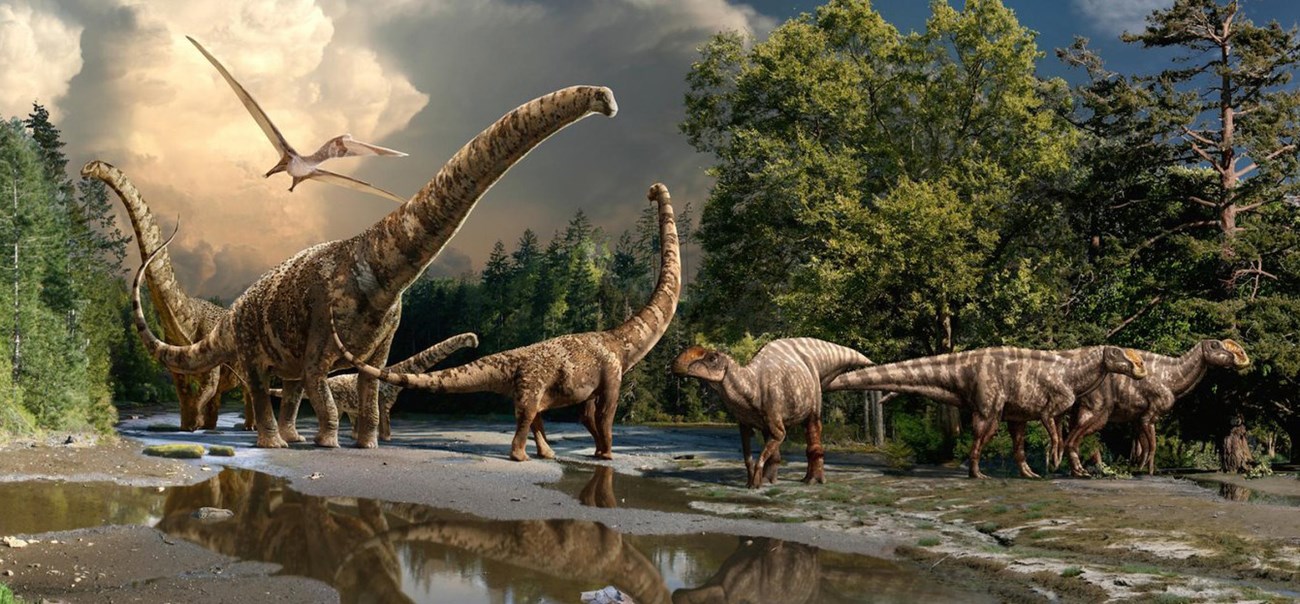
Paleoart by Julius Csotonyi and Alexandra Lefort.
The End-Cretaceous extinction at the Cretaceous-Paleogene (K-Pg) boundary (previously known as the K-T boundary for Cretaceous-Tertiary) is the mass extinction that is most popularly known. It is the closest to us today in time, occurring 66 million years ago. This extinction impacted both life on land and in the sea, with 76% of species, 40% of genera, and 17% of taxonomic families dying out.The End-Cretaceous extinction is also the most dramatic, according to what we know: An asteroid impact that formed the Chicxulub crater in the Yucatan caused instantaneous climate change and plunged Earth into darkness. The asteroid was an estimated 6–12 miles (10–20 km) in diameter, formed a crater nearly 120 miles (190 km) wide. This impact forever changed life on Earth, causing dinosaurs (except for birds) to become extinct, and in turn allowed mammals to flourish. Mammals first evolved in the Triassic but were small and not very abundant throughout the Mesozoic. Pterosaurs also went extinct, and birds were hit hard. The change in life that the End-Cretaceous mass extinction caused is also reflected in the nicknames for the two eras, the Age of Reptiles (or the Age of Dinosaurs) for the Mesozoic and the Age of Mammals for the Cenozoic.Marine life also was greatly impacted by the End-Cretaceous extinction. The great marine reptiles such as mosasaurs and plesiosaurs died out, as did some of their prey items such as ammonites and belemnites. Other groups of mollusks that went extinct include reef-forming rudist bivalves and giant inoceramid bivalves. Some marine planktonic microorganisms also became extinct at that time.
Related Links
-
NPS—Geologic Time Periods in the Mesozic Era—Cretaceous Period
- NPS—Age of Dinosaurs—Extinction Events
Mass Extinctions and the National Parks
Mass extinction has played a major role in shaping the fossil record of the national parks as a whole, although most of this evidence is indirect. Overall, National Park System lands contain few rock units that were deposited over the exact time interval when an extinction event occurred. The impact of extinction events on fossils present in the National Park System is best examined through examples that illustrate parts of this story.
Badlands National Park
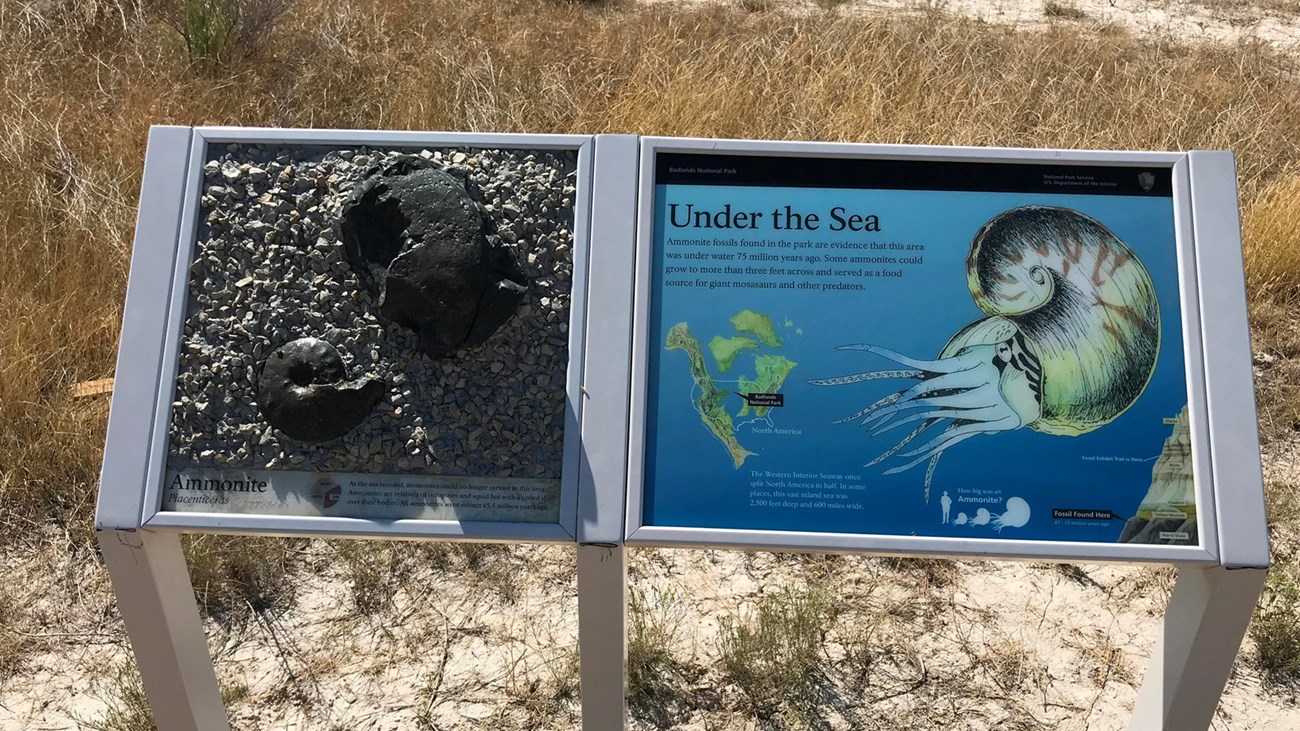
NPS Photo by Serena Rosales.
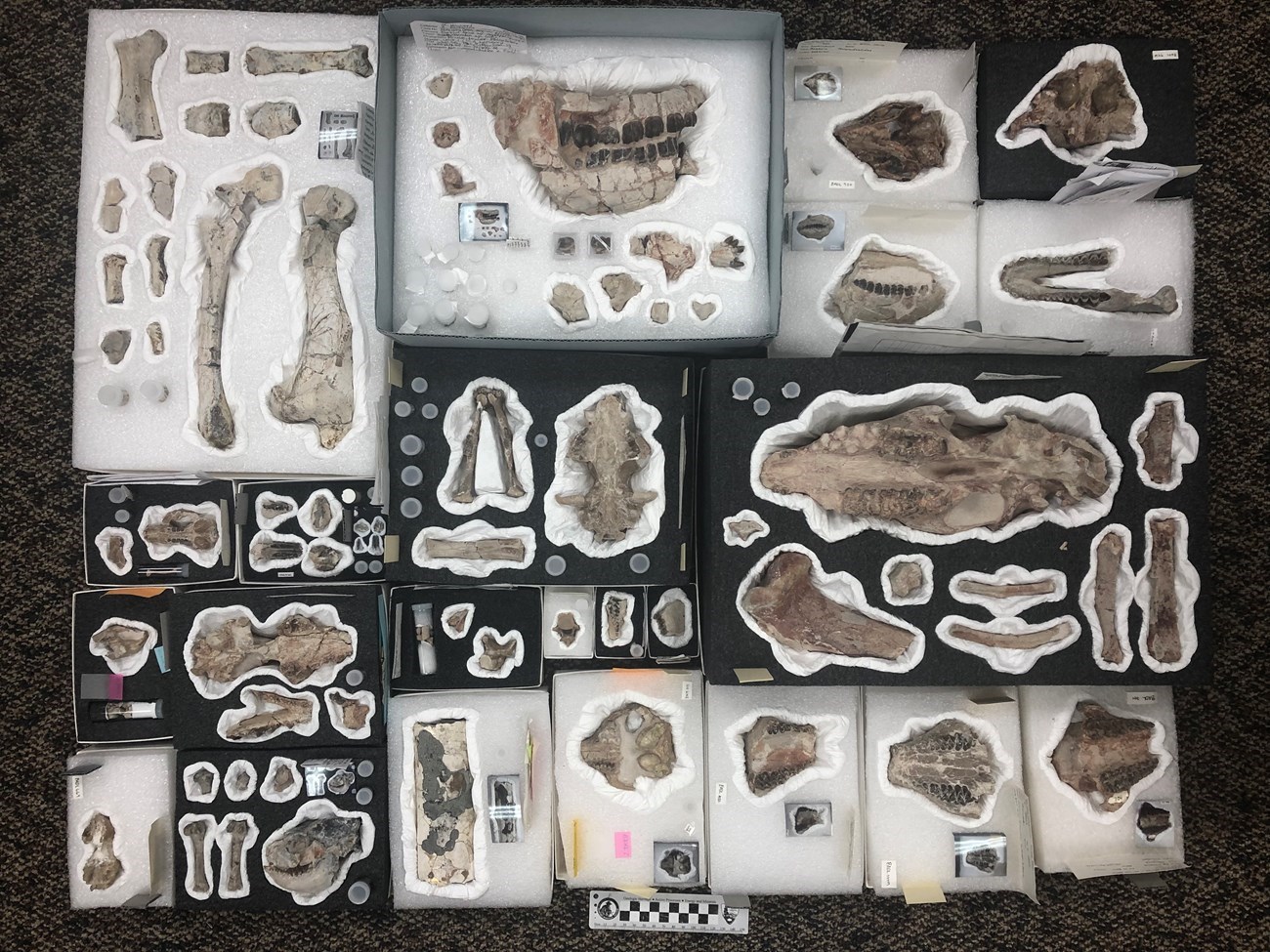
NPS photo.
Badlands National Park in South Dakota has a rich fossil record spanning from the Cretaceous through much of the Cenozoic. Although it does not have rocks from immediately at or near the End-Cretaceous extinction, Badlands’ fossil record does provide evidence of the change in the life across that time interval.
Cretaceous strata in Badlands are mostly marine or coastal in origin and were deposited in and along the shorelines of the Western Interior Seaway. Fossils in these rock units include specimens of animals that did not survive past the end of the Mesozoic, such as reptiles like mosasaurs and invertebrates such as ammonites and Inoceramus bivalves.
The Paleogene White River Group exposed in Badlands National Park contains a variety of mammal fossils who lived in floodplains, and along riverbanks and other terrestrial habitats. Although these rocks weren’t deposited in marine environments like the Cretaceous units in the park, the mammals and most of the other animals that lived in the Badlands area during the Cenozoic were very different from the dinosaurs that would have been dominant in the Mesozoic.
Big Bend National Park
Big Bend National Park is the only unit of the National Park System where rocks that span the Cretaceous-Paleogene boundary can be seen at the surface, although the iridium layer has not yet been identified in the park. Big Bend’s fossil record also shows evidence of the change in life that followed this mass extinction. The park contains both marine and terrestrial Mesozoic fossils including dinosaurs, mosasaurs, and certain marine invertebrates. Cenozoic fossils in the park include those of early mammals.
Related Links
Grand Canyon National Park
Grand Canyon National Park in Arizona contains an extensive rock record for much of the Paleozoic, especially for marine invertebrates. The park has many Paleozoic marine rock units, dating to the Cambrian, Devonian, Mississippian, Pennsylvanian, and Permian ages, bracketing the End-Ordovician and Late-Devonian extinctions. Although many of the same major invertebrate groups are found throughout these formations, such as trilobites, brachiopods, and mollusks, formations of different ages contain different genera and species of those animals, reflecting turnover.
Featured Link
Petrified Forest National Park in Arizona and Dinosaur National Monument
Yet most of the vertebrate fossils of the two parks are dominated by different groups. Petrified Forest National Park has abundant fossils of a bewildering variety of reptiles and amphibians that flourished during the Triassic but did not survive to the Jurassic, especially crocodile-like phytosaurs and armored herbivorous aetosaurs. A smaller number of fossils come from groups that survived the coming extinction and became dominant in the Jurassic, such as a few early dinosaurs. The Morrison Formation in Dinosaur National Monument lacks phytosaurs and aetosaurs, but has abundant fossils of large dinosaurs like Allosaurus, Apatosaurus, Camarasaurus, Diplodocus, and Stegosaurus.
West Bijou Site National Natural Landmark
The West Bijou Site was designated as a National Natural Landmark in 2016 because of its record of the Cretaceous-Paleogene (K-Pg) boundary, the time of the End-Cretaceous extinction. The site has a 1.2-inch (3-cm) thick layer with the iridium anomaly that marks the K-Pg boundary, and also contains other evidence (e.g., shocked quartz) of the asteroid impact that is thought to have occurred at this time. The West Bijou Site also has fossil spores from ferns that reflect the spike in extinctions at the boundary, plus both Cretaceous and Paleogene vertebrate fossils.
Featured Link
Featured Parks
-
Badlands National Park (BADL), South Dakota—[BADL Geodiversity Atlas] [BADL Park Home] [BADL npshistory.com]
-
Big Bend National Park (BIBE), Texas—[BIBE Geodiversity Atlas] [BIBE Park Home] [BIBE npshistory.com]
-
Biscayne National Park (BISC), Florida—[BISC Geodiversity Atlas] [BISC Park Home] [BISC npshistory.com]
-
Delaware Water Gap National Recreation Area (DEWA), New Jersey and Pennsylvania—[DEWA Geodiversity Atlas] [DEWA Park Home] [DEWA npshistory.com]
-
Grand Canyon National Park (GRCA), Arizona—[GRCA Geodiversity Atlas] [GRCA Park Home] [GRCA npshistory.com]
-
Grand Canyon-Parashant National Monument (PARA), Arizona—[PARA Geodiversity Atlas] [PARA Park Home] [PARA npshistory.com]
-
Great Basin National Park (GRBA), Nevada—[GRBA Geodiversity Atlas] [GRBA Park Home] [GRBA npshistory.com]
-
Petrified Forest National Park (PEFO), Arizona—[PEFO Geodiversity Atlas] [PEFO Park Home] [PEFO npshistory.com]
Last updated: February 28, 2025
